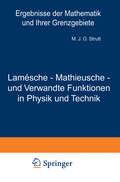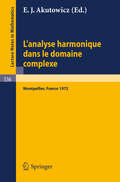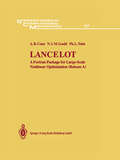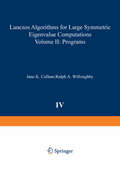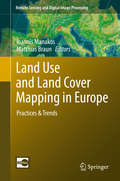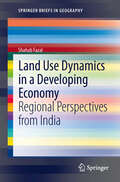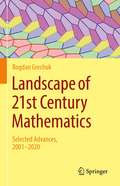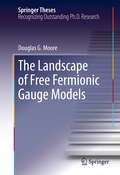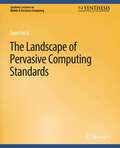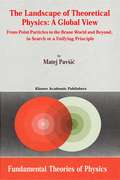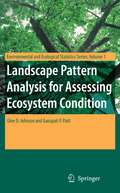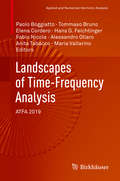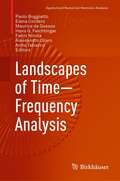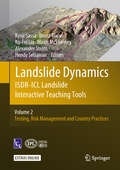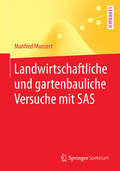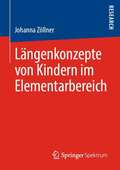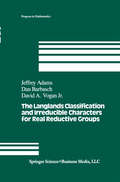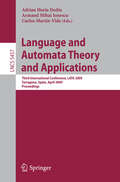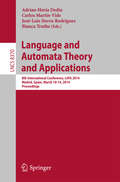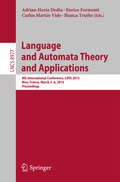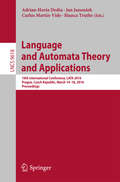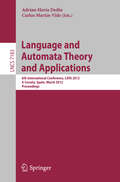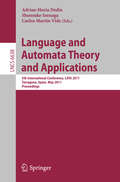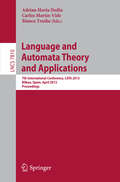- Table View
- List View
Lamésche - Mathieusche - und Verwandte Funktionen in Physik und Technik: Band 3 (Ergebnisse der Mathematik und Ihrer Grenzgebiete. 1. Folge #3)
by Maximilian J. StruttDieser Buchtitel ist Teil des Digitalisierungsprojekts Springer Book Archives mit Publikationen, die seit den Anfängen des Verlags von 1842 erschienen sind. Der Verlag stellt mit diesem Archiv Quellen für die historische wie auch die disziplingeschichtliche Forschung zur Verfügung, die jeweils im historischen Kontext betrachtet werden müssen. Dieser Titel erschien in der Zeit vor 1945 und wird daher in seiner zeittypischen politisch-ideologischen Ausrichtung vom Verlag nicht beworben.
L'Analyse Harmonique dans le Domaine Complexe: Actes de la Table Ronde Internationale du Centre National de la Recherche Scientifique tenue a Montpellier du 11 au 15 septembre 1972 (Lecture Notes in Mathematics #336)
by E. J. AkutowiczLancelot: A Fortran Package for Large-Scale Nonlinear Optimization (Release A) (Springer Series in Computational Mathematics #17)
by A.R. Conn G.I.M. Gould P.L. TointLANCELOT is a software package for solving large-scale nonlinear optimization problems. This book is our attempt to provide a coherent overview of the package and its use. This includes details of how one might present examples to the package, how the algorithm tries to solve these examples and various technical issues which may be useful to implementors of the software. We hope this book will be of use to both researchers and practitioners in nonlinear programming. Although the book is primarily concerned with a specific optimization package, the issues discussed have much wider implications for the design and im plementation of large-scale optimization algorithms. In particular, the book contains a proposal for a standard input format for large-scale optimization problems. This proposal is at the heart of the interface between a user's problem and the LANCE LOT optimization package. Furthermore, a large collection of over five hundred test ex amples has already been written in this format and will shortly be available to those who wish to use them. We would like to thank the many people and organizations who supported us in our enterprise. We first acknowledge the support provided by our employers, namely the the Facultes Universitaires Notre-Dame de la Paix (Namur, Belgium), Harwell Laboratory (UK), IBM Corporation (USA), Rutherford Appleton Laboratory (UK) and the University of Waterloo (Canada). We are grateful for the support we obtained from NSERC (Canada), NATO and AMOCO (UK).
Lanczos Algorithms for Large Symmetric Eigenvalue Computations Vol. II Programs (Progress in Scientific Computing #4)
by Cullum WilloughbyLand Use and Land Cover Mapping in Europe: Practices & Trends (Remote Sensing and Digital Image Processing #18)
by Ioannis Manakos Matthias BraunLand use and land cover (LULC) as well as its changes (LUCC) are an interplay between bio-geophysical characteristics of the landscape and climate as well as the complex human interaction including its different patterns of utilization superimposed on the natural vegetation. LULC is a core information layer for a variety of scientific and administrative tasks(e.g. hydrological modelling, climate models, land use planning).In particular in the context of climate change with its impacts on socio-economic, socio-ecologic systems as well as ecosystem services precise information on LULC and LUCC are mandatory baseline datasets required over large areas. Remote sensing can provide such information on different levels of detail and in a homogeneous and reliable way. Hence, LULC mapping can be regarded as a prototype for integrated approaches based on spaceborne and airborne remote sensing techniques combined with field observations. The book provides for the first time a comprehensive view of various LULC activities focusing on European initiatives, such as the LUCAS surveys, the CORINE land covers, the ESA/EU GMES program and its resulting Fast-Track- and Downstream Services, the EU JRC Global Land Cover, the ESA GlobCover project as well as the ESA initiative on Essential Climate Variables. All have and are producing highly appreciated land cover products. The book will cover the operational approaches, but also review current state-of-the-art scientific methodologies and recommendations for this field. It opens the view with best-practice examples that lead to a view that exceeds pure mapping, but to investigate into drivers and causes as well as future projections.
Land Use Dynamics in a Developing Economy: Regional Perspectives from India (SpringerBriefs in Geography)
by Shahab FazalToday, India still remains a rural agricultural country although the share of urban population has also increased but these figures do not tell the whole story. There are evidences that urban growth is dispersed and urban sprawl promotes the spread of urban land use into the rural-urban fringe. Here the attempt is to investigate the land transformation and the driving forces which were influencing the land transformation. The present study was done on peri urban interface of Aligarh city, a relatively small city, but as other north Indian cities, it is also expanding rapidly. Moreover, it too is surrounded by a populous rural area with productive and rich agricultural hinterland. Such conditions give rise to many conflicts and mutually beneficial complementarities in the rural and urban spheres. The result shows that the demand for land is high which results in informal urban development fulfilling the requirements of many of the city’s residents. Every piece of land is a tradable commodity, and the pursuit of short-term profits is the predominant ethic. The actors in PUI are strong because it is characterized by intermixing of rural and urban activities and interests as well as the number of actors are greater than in any other area..
Landscape of 21st Century Mathematics: Selected Advances, 2001–2020
by Bogdan GrechukLandscape of 21st Century Mathematics offers a detailed cross section of contemporary mathematics. Important results of the 21st century are motivated and formulated, providing an overview of recent progress in the discipline.The theorems presented in this book have been selected among recent achievements whose statements can be fully appreciated without extensive background. Grouped by subject, the selected theorems represent all major areas of mathematics: number theory, combinatorics, analysis, algebra, geometry and topology, probability and statistics, algorithms and complexity, and logic and set theory. The presentation is self-contained with context, background and necessary definitions provided for each theorem, all without sacrificing mathematical rigour. Where feasible, brief indications of the main ideas of a proof are given.Rigorous yet accessible, this book presents an array of breathtaking recent advances in mathematics. It is written for everyone with a background in mathematics, from inquisitive university students to mathematicians curious about recent achievements in areas beyond their own.
The Landscape of Free Fermionic Gauge Models (Springer Theses)
by Douglas G. MooreIn this thesis, the author describes the development of a software framework to systematically construct a particular class of weakly coupled free fermionic heterotic string models, dubbed gauge models. In their purest form, these models are maximally supersymmetric (N = 4), and thus only contain superpartners in their matter sector. This feature makes their systematic construction particularly efficient, and they are thus useful in their simplicity. The thesis first provides a brisk introduction to heterotic strings and the spin-structure construction of free fermionic models. Three systematic surveys are then presented, and it is conjectured that these surveys are exhaustive modulo redundancies. Finally, the author presents a collection of metaheuristic algorithms for searching the landscape for models with a user-specified spectrum of phenomenological properties, e.g. gauge group and number of spacetime supersymmetries. Such algorithms provide the groundwork for extended generic free fermionic surveys.
The Landscape of Pervasive Computing Standards (Synthesis Lectures on Mobile & Pervasive Computing)
by Sumi HelalThis lecture presents a first compendium of established and emerging standards in pervasive computing systems. The lecture explains the role of each of the covered standards and explains the relationship and interplay among them. Hopefully, the lecture will help piece together the various standards into a sensible and clear landscape. The lecture is a digest, reorganization, and a compilation of several short articles that have been published in the “Standards and Emerging Technologies” department of the IEEE Pervasive Computing magazine. The articles have been edited and shortened or expanded to provide the necessary focus and uniform coverage depth. There are more standards and common practices in pervasive systems than the lecture could cover. However, systems perspective and programmability of pervasive spaces, which are the main foci of the lecture, set the scope and determined which standards should be included. The lecture explains what it means to program a pervasive space and introduces the new requirements brought about by pervasive computing. Among the standards the lecture covers are sensors and device standards, service-oriented device standards, service discovery and delivery standards, service gateway standards, and standards for universal interactions with pervasive spaces. In addition, the emerging sensor platform and domestic robots technologies are covered and their essential new roles explained. The lecture also briefly covers a set of standards that represents an ecosystem for the emerging pervasive healthcare industry. Audiences who may benefit from this lecture include (1) academic and industrial researchers working on sensor-based, pervasive, or ubiquitous computing R&D; (2) system integrator consultants and firms, especially those concerned with integrating sensors, actuators, and devices to their enterprise and business systems; (3) device, smart chips, and sensor manufacturers; (4) government agencies; (5) the healthcare IT and pervasive health industries; and (6) other industries such as logistics, manufacturing, and the emerging smart grid and environment sustainability industries. Table of Contents: Preface / Acknowledgments / Introduction / Sensor and Device Standards / Service-Oriented Device Architecture (SODA) / Sensor Platforms / Service Discovery and Delivery Standards / The Open Services Gateway Initiative (OSGi ) / Universal Interactions / Domestic Robots for Smart Space Interactions / Continua: An Interoperable Personal Health Echosystem / References / Author Biography
The Landscape of Theoretical Physics: From Point Particles to the Brane World and Beyond in Search of a Unifying Principle (Fundamental Theories of Physics #119)
by M. PavsicToday many important directions of research are being pursued more or less independently of each other. These are, for instance, strings and mem branes, induced gravity, embedding of spacetime into a higher dimensional space, the brane world scenario, the quantum theory in curved spaces, Fock Schwinger proper time formalism, parametrized relativistic quantum the ory, quantum gravity, wormholes and the problem of “time machines”, spin and supersymmetry, geometric calculus based on Clifford algebra, various interpretations of quantum mechanics including the Everett interpretation, and the recent important approach known as “decoherence”. A big problem, as I see it, is that various people thoroughly investigate their narrow field without being aware of certain very close relations to other fields of research. What we need now is not only to see the trees but also the forest. In the present book I intend to do just that: to carry out a first approximation to a synthesis of the related fundamental theories of physics. I sincerely hope that such a book will be useful to physicists. From a certain viewpoint the book could be considered as a course in the oretical physics in which the foundations of all those relevant fundamental theories and concepts are attempted to be thoroughly reviewed. Unsolved problems and paradoxes are pointed out. I show that most of those ap proaches have a common basis in the theory of unconstrained membranes. The very interesting and important concept of membrane space, the tensor calculus in and functional transformations in are discussed.
Landscape Pattern Analysis for Assessing Ecosystem Condition (Environmental and Ecological Statistics #1)
by Glen D. Johnson Ganapati P. PatilThis book presents a new method for assessing spatial pattern in raster land cover maps based on satellite imagery in a way that incorporates multiple pixel resolutions. This is combined with more conventional single-resolution measurements of spatial pattern and simple non-spatial land cover proportions to assess predictability of both surface water quality and ecological integrity within watersheds of the state of Pennsylvania (USA).
Landscapes of Investigation: Contributions to Critical Mathematics Education (Studies on Mathematics Education and Society #1)
by Miriam Godoy Penteado and Ole SkovsmoseCreating landscapes of investigation is a primary concern of critical mathematics education. It enables us to organise educational processes so that students and teachers are able to get involved in explorations guided by dialogical interactions. It attempts to address explicit or implicit forms of social injustice by means of mathematics, and also to promote a critical conception of mathematics, challenging the assumption that the subject represents objectivity and neutrality. Landscapes of Investigation provides many illustrations of how this can be done in primary, secondary, and university education. It also illustrates how exploring landscapes of investigation can contribute to mathematics teacher education programmes. This edited volume is the result of a collaboration established through the Colloquium in Research in Critical Mathematics Education, which took place in 2016, 2018, and 2019 in Brazil. Its twenty-eight contributors are young researchers from Brazil, Chile, Colombia, India, Mexico and the USA, who are dedicated to the further development of critical mathematics education. Organised in eighteen chapters, the volume presents examples of engaging students from a diversity of social and economic backgrounds, age ranges, and abilities across different countries. The chapters present original findings on the social aspects of all levels of mathematics education. Landscapes of Investigation is of particular relevance to those with an interest in the potential of mathematics education to challenge social injustices.
Landscapes of Time-Frequency Analysis: ATFA 2019 (Applied and Numerical Harmonic Analysis)
by Paolo Boggiatto Tommaso Bruno Elena Cordero Hans G. Feichtinger Fabio Nicola Alessandro Oliaro Anita Tabacco Maria VallarinoThis contributed volume features chapters based on talks given at the second international conference titled Aspects of Time-Frequency Analysis (ATFA 19), held at Politecnico di Torino from June 25th to June 27th, 2019. Written by experts in harmonic analysis and its applications, these chapters provide a valuable overview of the state-of-the-art of this active area of research. New results are collected as well, making this a valuable resource for readers seeking to be brought up-to-date. Topics covered include:Signal analysisQuantum theoryModulation space theoryApplications to the medical industryWavelet transform theoryAnti-Wick operatorsLandscapes of Time-Frequency Analysis: ATFA 2019 will be of particular interest to researchers and advanced students working in time-frequency analysis and other related areas of harmonic analysis.
Landscapes of Time-Frequency Analysis (Applied and Numerical Harmonic Analysis)
by Anita Tabacco Paolo Boggiatto Elena Cordero Maurice De Gosson Hans G. Feichtinger Fabio Nicola Alessandro OliaroThe chapters in this volume are based on talks given at the inaugural Aspects of Time-Frequency Analysis conference held in Turin, Italy from July 5-7, 2017, which brought together experts in harmonic analysis and its applications. New connections between different but related areas were presented in the context of time-frequency analysis, encouraging future research and collaborations. Some of the topics covered include:Abstract harmonic analysis,Numerical harmonic analysis,Sampling theory,Compressed sensing,Mathematical signal processing,Pseudodifferential operators, andApplications of harmonic analysis to quantum mechanics.Landscapes of Time-Frequency Analysis will be of particular interest to researchers and advanced students working in time-frequency analysis and other related areas of harmonic analysis.
Landslide Dynamics: Volume 2: Testing, Risk Management and Country Practices
by Kyoji Sassa Binod Tiwari Ko-Fei Liu Mauri McSaveney Alexander Strom Hendy SetiawanThis interactive book presents comprehensive information on the fundamentals of landslide types and dynamics, while also providing a set of PPT, PDF, and text tools for education and capacity development. It is the second part of a two-volume work created as the core activity of the Sendai Partnerships, the International Consortium of Landslides. The book will be regularly updated and improved over the coming years, based on responses from users and lessons learned during its application.
Landwirtschaftliche und gartenbauliche Versuche mit SAS: Mit 50 Programmen, 169 Tabellen und 18 Abbildungen (Springer-Lehrbuch)
by Manfred MunzertDieses Lehrbuch ist anwendungsorientiert ausgerichtet und verzichtet auf eine detaillierte Darstellung der Theorie. Auf wichtige Grundlagen der Statistik und der Programmiersprache SAS, die für das Verständnis der angewandten SAS-Prozeduren von Bedeutung sind, wird jedoch eingegangen. In zwei einleitenden Kapiteln erhält der Leser Hinweise zum statistischen Fundament der Versuchsbeispiele und wie man Versuchsdaten in SAS importiert. Die folgenden 50 Beispiele aus der Versuchspraxis sind immer gleich gegliedert: Problembeschreibung, Erklärung des SAS-Programms, Darstellung der wichtigsten Teile des SAS-Outputs mit Interpretation der Ergebnisse, weiterführende Hinweise zum Themenkomplex und evtl. Querverweise zu anderen Beispielen. In den meisten Fällen wurden bewusst Lehrbuchbeispiele der älteren Literatur aufgegriffen, so dass der Leser die Möglichkeit hat, die Ergebnisse mit der dort konventionell vorgenommenen Auswertung und Darstellung zu vergleichen. Die einschlägige neuere Literatur wird jedoch auch berücksichtigt.
Längenkonzepte von Kindern im Elementarbereich
by Johanna ZöllnerDer alltägliche Umgang mit Längen spielt für Kinder im Elementarbereich eine bedeutende Rolle und birgt reiches mathematisches Förderpotenzial. Dennoch stehen Längen selten im Fokus der frühen mathematischen Bildung. Johanna Zöllner entwickelt auf theoretischer und empirischer Basis ein Modell, das Längenkonzepte als komplexes Zusammenspiel vielfältiger Komponenten beschreibt, die im mentalen sowie im handelnden Umgang mit Längen zum Tragen kommen. Ein umfassendes Verständnis dieser Komponenten ist grundlegend für eine adäquate Unterstützung der Kinder beim Aufbau von Längenkonzepten. Die Studie bietet wertvolle Erkenntnisse für die Gestaltung von Lehr- und Lernumgebungen, zudem eröffnen detaillierte Auswertungskategorien Diagnosemöglichkeiten und bilden eine Basis für die weitere wissenschaftliche Auseinandersetzung mit Größenkonzepten.
The Langlands Classification and Irreducible Characters for Real Reductive Groups (Progress in Mathematics #104)
by J. Adams D. Barbasch D.A. VoganThis monograph explores the geometry of the local Langlands conjecture. The conjecture predicts a parametrizations of the irreducible representations of a reductive algebraic group over a local field in terms of the complex dual group and the Weil-Deligne group. For p-adic fields, this conjecture has not been proved; but it has been refined to a detailed collection of (conjectural) relationships between p-adic representation theory and geometry on the space of p-adic representation theory and geometry on the space of p-adic Langlands parameters. This book provides and introduction to some modern geometric methods in representation theory. It is addressed to graduate students and research workers in representation theory and in automorphic forms.
Language and Automata Theory and Applications: Third International Conference, LATA 2009, Tarragona, Spain, April 2-8, 2009. Proceedings (Lecture Notes in Computer Science #5457)
by Adrian Horia Dediu Armand Mihai Ionescu Carlos Martin-VideThis book constitutes the refereed proceedings of the Third International Conference on Language and Automata Theory and Applications, LATA 2009, held in Tarragona, Spain, in April 2009. The 58 revised full papers presented together with 3 invited lectures and two tutorials were carefully reviewed and selected from 121 submissions. The papers address all the various issues related to automata theory and formal languages.
Language and Automata Theory and Applications: 8th International Conference, LATA 2014, Madrid, Spain, March 10-14, 2014, Proceedings (Lecture Notes in Computer Science #8370)
by Adrian Horia Dediu Carlos Martín-Vide José-Luis Sierra-Rodríguez Bianca TrutheThis book constitutes the refereed proceedings of the 8th International Conference on Language and Automata Theory and Applications, LATA 2014, held in Madrid, Spain in March 2014.The 45 revised full papers presented together with 4 invited talks were carefully reviewed and selected from 116 submissions. The papers cover the following topics: algebraic language theory; algorithms on automata and words; automata and logic; automata for system analysis and program verification; automata, concurrency and Petri nets; automatic structures; combinatorics on words; computability; computational complexity; descriptional complexity; DNA and other models of bio-inspired computing; foundations of finite state technology; foundations of XML; grammars (Chomsky hierarchy, contextual, unification, categorial, etc.); grammatical inference and algorithmic learning; graphs and graph transformation; language varieties and semigroups; parsing; patterns; quantum, chemical and optical computing; semantics; string and combinatorial issues in computational biology and bioinformatics; string processing algorithms; symbolic dynamics; term rewriting; transducers; trees, tree languages and tree automata; weighted automata.
Language and Automata Theory and Applications: 9th International Conference, LATA 2015, Nice, France, March 2-6, 2015, Proceedings (Lecture Notes in Computer Science #8977)
by Adrian-Horia Dediu Enrico Formenti Carlos Martín-Vide Bianca TrutheThis book constitutes the refereed proceedings of the 9th International Conference on Language and Automata Theory and Applications, LATA 2015, held in Nice, France in March 2015. The 53 revised full papers presented together with 5 invited talks were carefully reviewed and selected from 115 submissions. The papers cover the following topics: algebraic language theory; algorithms for semi-structured data mining, algorithms on automata and words; automata and logic; automata for system analysis and program verification; automata networks, concurrency and Petri nets; automatic structures; cellular automata, codes, combinatorics on words; computational complexity; data and image compression; descriptional complexity; digital libraries and document engineering; foundations of finite state technology; foundations of XML; fuzzy and rough languages; grammatical inference and algorithmic learning; graphs and graph transformation; language varieties and semigroups; parallel and regulated rewriting; parsing; patterns; string and combinatorial issues in computational biology and bioinformatics; string processing algorithms; symbolic dynamics; term rewriting; transducers; trees, tree languages and tree automata; weighted automata.
Language and Automata Theory and Applications: 10th International Conference, LATA 2016, Prague, Czech Republic, March 14-18, 2016, Proceedings (Lecture Notes in Computer Science #9618)
by Adrian-Horia Dediu Jan Janoušek Carlos Martín-Vide Bianca TrutheThis book constitutes the refereed proceedings of the 10th International Conference on Language and Automata Theory and Applications, LATA 2016, held in Prague, Czech Republic, in March 2016. The 42 revised full papers presented together with 5 invited talks were carefully reviewed and selected from 119 submissions. The papers cover the following topics: algebraic language theory; algorithms for semi-structured data mining, algorithms on automata and words; automata and logic; automata for system analysis and program verification; automata networks, concurrency and Petri nets; automatic structures; cellular automata, codes, combinatorics on words; computational complexity; data and image compression; descriptional complexity; digital libraries and document engineering; foundations of finite state technology; foundations of XML; fuzzy and rough languages; grammatical inference and algorithmic learning; graphs and graph transformation; language varieties and semigroups; parallel and regulated rewriting; parsing; patterns; string and combinatorial issues in computational biology and bioinformatics; string processing algorithms; symbolic dynamics; term rewriting; transducers; trees, tree languages and tree automata; weighted automata.
Language and Automata Theory and Applications: 6th International Conference, LATA 2012, A Coruña, Spain, March 5-9, 2012, Proceedings (Lecture Notes in Computer Science #7183)
by Adrian-Horia Dediu Carlos Martín-VideThis book constitutes the refereed proceedings of the 6th International Conference on Language and Automata Theory and Applications, LATA 2012, held in A Coruña, Spain in March 2012. The 41 revised full papers presented together with 3 invited talks and 2 invited tutorials were carefully reviewed and selected from 114 initial submissions. The volume features contributions from both classical theory fields and application areas; e.g. innformatics, systems biology, language technology, artificial intelligence, etc. Among the topics covered are algebraic language theory, automata and logic, systems analysis, systems verifications, computational complexity, decidability, unification, graph transformations, language-based cryptography, and applications in data mining, computational learning, and pattern recognition.
Language and Automata Theory and Applications: 5th International Conference, LATA 2011, Tarragona, Spain, May 26-31, 2011 (Lecture Notes in Computer Science #6638)
by Adrian-Horia Dediu Carlos Martín-Vide Shunsuke InenagaThis book constitutes the refereed proceedings of the 5th International Conference on Language and Automata Theory and Applications, LATA 2011, held in Tarragona, Spain in May 2011. The 36 revised full papers presented together with four invited articles were carefully selected from 91 submissions. Among the topics covered are algebraic language theory, automata and logic, systems analysis, systems verifications, computational complexity, decidability, unification, graph transformations, language-based cryptography, and applications in data mining, computational learning, and pattern recognition.
Language and Automata Theory and Applications: 7th International Conference, LATA 2013, Bilbao, Spain, April 2-5, 2013, Proceedings (Lecture Notes in Computer Science #7810)
by Adrian-Horia Dediu Carlos Martín-Vide Bianca TrutheThis book constitutes the refereed proceedings of the 7th International Conference on Language and Automata Theory and Applications, LATA 2013, held in Bilbao, Spain in April 2013. The 45 revised full papers presented together with 5 invited talks were carefully reviewed and selected from 97 initial submissions. The volume features contributions from both classical theory fields and application areas (bioinformatics, systems biology, language technology, artificial intelligence, etc.). Among the topics covered are algebraic language theory; algorithms for semi-structured data mining; algorithms on automata and words; automata and logic; automata for system analysis and program verification; automata, concurrency and Petri nets; automatic structures; cellular automata; combinatorics on words; computability; computational complexity; computational linguistics; data and image compression; decidability questions on words and languages; descriptional complexity; DNA and other models of bio-inspired computing; document engineering; foundations of finite state technology; foundations of XML; fuzzy and rough languages; grammars (Chomsky hierarchy, contextual, multidimensional, unification, categorial, etc.); grammars and automata architectures; grammatical inference and algorithmic learning; graphs and graph transformation; language varieties and semigroups; language-based cryptography; language-theoretic foundations of artificial intelligence and artificial life; parallel and regulated rewriting; parsing; pattern recognition; patterns and codes; power series; quantum, chemical and optical computing; semantics; string and combinatorial issues in computational biology and bioinformatics; string processing algorithms; symbolic dynamics; symbolic neural networks; term rewriting; transducers; trees, tree languages and tree automata; weighted automata.
